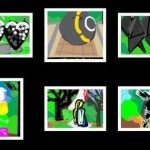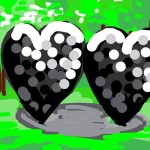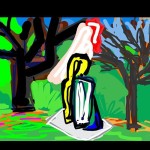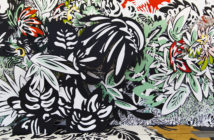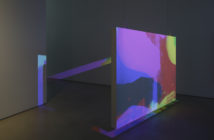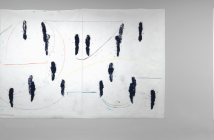If you’re on Twitter, you may have come across the hashtag #DrawArt. On Thursday 16 May, 2013, deCordova Sculpture Park and Museum invited Paige Dansinger, artist, art historian, and #DrawArt iPad program designer (@MuseumPaige) for a digital "Draw in the Park" one-day residency. Over the course of the day, Dansinger made 14 images based on works in the Museum’s collection, and shared them via Facebook, Twitter, Instagram, and Tumblr.
deCordova is the second institution in Massachusetts after the Worcester Art Museum to participate in the #DrawArt residency via Twitter. The Worcester Art Museum, which hosted Dansinger earlier this Spring, continually encourages all visitors to become one-day residents by inviting them to sketch, draw, photograph, write, or create works inspired by the museum’s renowned collections. Developed by Adam Reed Rozan, Director of Audience Engagement at the Museum, all works created during the One-Day Residency are stored on the Museum’s Flickr account, and promoted extensively through Facebook and Twitter.
Watch the drawing
The #DrawArt app, developed with Clement Shimizu of The Elumenati, was inspired by Zynga's Draw Something, an app that lets participants guess each other’s drawings and win points, which are exchanged for more colors. Developed with the goal of making #DrawArt into an educational learning tool for kids and adults, the program is "an artist driven projection experience with multi-user mobile companion that extends the museum experience with enhanced content and live art video playback." The purpose, according to Dansinger, is to "engage audiences, ignite wonder and inspire communities." The app also makes a strong case for museums to digitize and make their collections easily accessible online. It encourages prospective visitors and art lovers to become familiar with a museum’s collection prior to visiting, and while they're not looking at the actual objects, it pushes visitors to start connecting the dots and make relationships with the world that surrounds them. "I have never been to Worcester, MA but I have literally spent the day there using a mobile phone and tablet," Dansinger wrote in a blog post about her experience with the Worcester Art Museum. To date, Paige Dansinger has made over 1,000 works on her iPhone and iPad, and has all her drawings organized by museum, historical period, geographical region, style, and artist.
One of the few museums in New England using Twitter to engage its audience beyond its walls (and Sculpture Park), and one which has fun using it, deCordova held the #DrawArt digital residency in conjunction with Deborah Putnoi’s The Drawing Lab (March 30 - May 19, 2013), an interactive installation that explored the drawing process by encouraging visitors to take a clipboard and pencil out in the Park. "Since we close the Museum for several weeks three times per year while we switch out the exhibitions, it seemed a great way to draw attention to the Park in the Spring, show off our newer pieces, encourage active art-making, and just have some fun!", Jennifer Schmitt, Head of Information Technology and Electronic Communications, wrote in an email. "I love trying to find new ways to use it to connect with followers/visitors beyond the usual photos, posts etc.," she added.
While it is true that not every museum has a collection as expansive as those of the Cleveland Museum of Art, or the Museum of Fine Arts, Boston, nor can afford to share it on a similar level to what the Cleveland Museum did with Gallery One, museums across the country can encourage visitors to look closely at art, using tools like #DrawArt, and to share their experiences on social media, yet very few are doing this today.
One day online residency programs, like the Worcester Art Museum's, and the recent collaboration between Paige Dansinger and deCordova, give collections more public exposure and make them more accessible by using social media outlets to prompt engagement. "But if the collection is still a key piece of the mission of an institution, how do we activate it in a manner that reaches the public and makes it engaging?", says Schmitt adding that she thinks Dansinger’s digital residency is a great way to highlight museum objects that would otherwise be relegated to the background.
"I think it's fantastic that Boston-area museums are catching up to digital media" says Paige Dansinger, adding that both residencies were organized and conducted entirely through Twitter. "With Twitter and other forms of social media, collaborations, and artist residencies such as these are born in seconds across our mobile phones."
"I am an advocate for Open Data and believe that museums should digitize and upload their collections on Wikipedia or Google Art Project," says Dansinger, adding that there are many museums out there that are already leaders and are setting examples for other museums and organizations in providing engaging, free-content to ensure Wikipedia becomes an excellent resource for younger audiences. "The collection [of the Museum of Islamic Art in Qatar]found on Google Art Project has inspired me to consider my identity and the Hebrew concept of Tikun Olam, or healing the world, in new cross-cultural ways through #DrawArt."
According to Paige Dansinger, the reception of the #DrawArt program has been phenomenal, so much so that the artist was included in the recent exhibition Gutai: Splendid Playground at the Guggenheim Museum in New York. Dansinger donated 200 Digital Trading Card Stickers that she made using #DrawArt program for the digital cardbox component of Gutai Splendid Playground. A recreation of the 1952 original, the Gutai Card Box is a large box with a person inside who drops a card out a slot whenever someone puts a coin in machine. "The Gutai Manifesto calls for doing new things. I tried new things I had never done before by working with technology that was new to me," says Dansinger, adding that on this occasion she learned how to use QR codes which would lead to a video animation on YouTube.
- Image courtesy of Paige Dansinger.
- Two Big Black Hearts, Jim Dine, 1985 at @decordovaspandm. Image courtesy of Paige Dansinger. Watch the drawing
- Five Brushstrokes, Roy Lichtenstein, 1984 at @deCordovaSPandM. Image courtesy of Paige Dansinger. Watch the drawing
- Buzzing it Down, 2012 at @decordovaspandm. Image courtesy of Paige Dansinger. Watch the drawing
- Campbell’s Soup Can (Tomato), Andy Warhol, 1965 at @WorcesterArt Image courtesy of Paige Dansinger. Watch the drawing
- Tower, Sol LeWitt, 2009 at @deCordovaSPandM Watch the drawing



